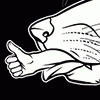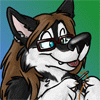
Prematurely Fledged Brown-Headed Cowbird
Location: Nashville, TN, USA
EDIT: Thank you all for your comments! After reading all of your suggestions, the possibility of this bird being a Brown-Headed Cowbird seems the most likely. : ) All birds are just as worthy of admiration, though, in my eyes. They're rather interesting any way you look at them, brood parasite or not!
As I was working on artwork yesterday afternoon, the two floor-to-ceiling windows in front of my desk granted me an interesting sight. Two crows caught my attention as they landed on the grass near the window, and they were pecking at a small lighter-colored object.
Not a few seconds afterward, the two barn cats we own chased away the crows, and then Buckle (one of the cats) walked back with that same blob in his mouth. I then realized that this blob was something that was alive, and cheeping. I ran out and got Buckle to drop the blob, and saw that is was a chick, only partially feathered and unable to fly. It gaped at me with alarm cheeps to try to scare me off, so I went and covered it with a small plastic plant pot with holes on the top to calm the bird down.
After a few minutes of keeping the cats at bay and leaving the bird be, I grabbed my camera and took photos. The bird was much calmer by now and allowed me to gently lift its wings to check for injuries - it seemed to be unharmed in any outward fashion.
Looking for any potential nests it could have fallen out of, I located a decent-sized nest cup in the bush not three feet away from the chick, and found a blue egg with brownish spots on it inside - no other shell fragments were seen, and the egg had a small amount of brown goo pooled inside of it (most likely extra fluids and membranes from when the egg hatched, or the contents of an unhatched egg that was broken into).
While I was investigating the nest, I suddenly noticed that in a tree nearby, a male Scarlet Tanager was tilting his head in the direction of myself and the chick, calling with soft chups. This made me question the species even more so, wondering if this chick might belong to that male tanager. This called into question my first guess of what this chick might be, a Brown-Headed Cowbird.
After attempting to search for images of pre-fledgeling chicks of either species, a lot of various variables and evidence does not add up.
The egg in the nest (later viewed with a flashlight at dusk) appears to be rightly bluish colored, which indicates a greater possibility of a Scarlet Tanager. However, the nest it is in does not indicate that of a Tanager's placement - Scarlet Tanagers nest up in the canopy, often around 50 feet or more off of the ground. This nest is not even three feet off the ground, and I have been told that this nest has been there for several years. A seemingly fresh egg, however, indicates activity at that nest.
If the chick is a Cowbird, the egg's size and color comes into question, along with where any other eggs may have gone, if there were any.
There is also the chance that this nest is not connected to the two birds at all, and the chick had fallen from a much higher point, and would not be able to be replaced in its nest.
The lack of breast streaking also points to the bird being a Cowbird, though at this stage of feather development, any streaking may be masked by sheer lack of feather coverage. The bill's gape color is also not typical of a Scarlet Tanager, whose gapes seem to be yellow-orange compared to this chick's white gape.
After the photos, I placed this chick in the nest, which may or may not have been a smart decision, and it scrambled out to the outer branches of the bush and cheeped softly, potentially calling for food. Leaving it alone for about 3 hours, I came back at dusk to see if it was still there, and I was unable to find it anywhere. We had plans to bring it to a rehab center if the chick was still present this morning, and it hasn't been. If it had died due to my meddling, it was purely by my naivete, and I say this with a heavy heart.
Even though this bird may have been of a species known for its brood parasitism, it is still a species that should be respected. I am happy to have had this encounter with it.
Photos taken by myself, Stephanie Dziezyk 2013. May be used for reference and stock imagery (with citation of photos' source provided in the images it is used in).
EDIT: Thank you all for your comments! After reading all of your suggestions, the possibility of this bird being a Brown-Headed Cowbird seems the most likely. : ) All birds are just as worthy of admiration, though, in my eyes. They're rather interesting any way you look at them, brood parasite or not!
As I was working on artwork yesterday afternoon, the two floor-to-ceiling windows in front of my desk granted me an interesting sight. Two crows caught my attention as they landed on the grass near the window, and they were pecking at a small lighter-colored object.
Not a few seconds afterward, the two barn cats we own chased away the crows, and then Buckle (one of the cats) walked back with that same blob in his mouth. I then realized that this blob was something that was alive, and cheeping. I ran out and got Buckle to drop the blob, and saw that is was a chick, only partially feathered and unable to fly. It gaped at me with alarm cheeps to try to scare me off, so I went and covered it with a small plastic plant pot with holes on the top to calm the bird down.
After a few minutes of keeping the cats at bay and leaving the bird be, I grabbed my camera and took photos. The bird was much calmer by now and allowed me to gently lift its wings to check for injuries - it seemed to be unharmed in any outward fashion.
Looking for any potential nests it could have fallen out of, I located a decent-sized nest cup in the bush not three feet away from the chick, and found a blue egg with brownish spots on it inside - no other shell fragments were seen, and the egg had a small amount of brown goo pooled inside of it (most likely extra fluids and membranes from when the egg hatched, or the contents of an unhatched egg that was broken into).
While I was investigating the nest, I suddenly noticed that in a tree nearby, a male Scarlet Tanager was tilting his head in the direction of myself and the chick, calling with soft chups. This made me question the species even more so, wondering if this chick might belong to that male tanager. This called into question my first guess of what this chick might be, a Brown-Headed Cowbird.
After attempting to search for images of pre-fledgeling chicks of either species, a lot of various variables and evidence does not add up.
The egg in the nest (later viewed with a flashlight at dusk) appears to be rightly bluish colored, which indicates a greater possibility of a Scarlet Tanager. However, the nest it is in does not indicate that of a Tanager's placement - Scarlet Tanagers nest up in the canopy, often around 50 feet or more off of the ground. This nest is not even three feet off the ground, and I have been told that this nest has been there for several years. A seemingly fresh egg, however, indicates activity at that nest.
If the chick is a Cowbird, the egg's size and color comes into question, along with where any other eggs may have gone, if there were any.
There is also the chance that this nest is not connected to the two birds at all, and the chick had fallen from a much higher point, and would not be able to be replaced in its nest.
The lack of breast streaking also points to the bird being a Cowbird, though at this stage of feather development, any streaking may be masked by sheer lack of feather coverage. The bill's gape color is also not typical of a Scarlet Tanager, whose gapes seem to be yellow-orange compared to this chick's white gape.
After the photos, I placed this chick in the nest, which may or may not have been a smart decision, and it scrambled out to the outer branches of the bush and cheeped softly, potentially calling for food. Leaving it alone for about 3 hours, I came back at dusk to see if it was still there, and I was unable to find it anywhere. We had plans to bring it to a rehab center if the chick was still present this morning, and it hasn't been. If it had died due to my meddling, it was purely by my naivete, and I say this with a heavy heart.
Even though this bird may have been of a species known for its brood parasitism, it is still a species that should be respected. I am happy to have had this encounter with it.
Photos taken by myself, Stephanie Dziezyk 2013. May be used for reference and stock imagery (with citation of photos' source provided in the images it is used in).
Category Photography / Animal related (non-anthro)
Species Avian (Other)
Size 1200 x 717px
File Size 1.96 MB
Looks like the cowbird to me (though I'm in the uk so I'm not familiar with them).
If it is a parasitic brood species the parents may have rejected it- it's actually fairly common that the parents notice the young isn't the same species. This happens more frequently if the egg is layed in the nest of a bird which is not normally targeted (as the parasitic bird will not have evolved the same egg markings or feeding ques)
Either way the best thing you can do is place the bird back in the nest, especially one as young as this. If the parents had rejected it chances are the bird would have tried to find them and not survived. It definitely wasn't your fault if the bird has died- you did everything right.
Hope my crappy knowledge helped a bit :) I'm fascinated by brood parasitism.
If it is a parasitic brood species the parents may have rejected it- it's actually fairly common that the parents notice the young isn't the same species. This happens more frequently if the egg is layed in the nest of a bird which is not normally targeted (as the parasitic bird will not have evolved the same egg markings or feeding ques)
Either way the best thing you can do is place the bird back in the nest, especially one as young as this. If the parents had rejected it chances are the bird would have tried to find them and not survived. It definitely wasn't your fault if the bird has died- you did everything right.
Hope my crappy knowledge helped a bit :) I'm fascinated by brood parasitism.
You wouldn't have found any egg shell usually, parent birds keep the nests meticulously clean, USUALLY, but that also depends on the bird some don't do a great deal of "house work". Just as long as it's somewhere out of reach of cats and other predators the parents SHOULD carry on feeding it as has been said. Touching it shouldn't make a difference. Generally most wildlife rescue centres will tell you that leaving baby birds somewhere safe where parents can get to it but nothing predatory is the best thing you can do.

 FA+
FA+













Comments